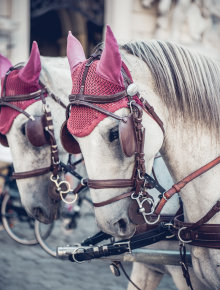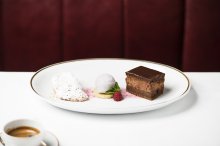At the Grand Ferdinand in Vienna, the fondness for the Habsburg era shows itself in the affectionate minutiae of the decor as well as the menus of the hotel’s restaurants. Among other things, the Grand Ferdinand restaurant on the ground floor serves historically inspired dishes like the minced meat fritters á la Metternich or the dessert Rigó Jancsi. The violet sorbet à la Sisi completes the historical menu.
Empress Elisabeth’s Favourite Ice Cream
“Violet Sorbet à la Sisi” at the Grand Ferdinand in Vienna
A light, dairy-free sorbet
Violet sorbet is an Austrian speciality. Its connection to Empress Elisabeth, known as Sisi or (in the film series by Ernst Marischka) Sissi, is no coincidence. The Austrian empress was an avid fan of the sorbet which became an important part of her many dieting fads.
The sorbet doesn’t have any milk in it which makes it particularly digestible. The dessert derives its purple colour from the juice of violets, Sisi’s favourite flowers. The juice is then mixed with sugar and water and finished with some champagne.
The special allure of Sisi
The musical “Elisabeth”, the lasting popularity of the “Sissi” films with Romy Schneider and the abundance of Sisi biographies available go to show that to this day, the tragic empress fascinates many people around the world.
Sisi was born on Christmas eve 1837 as Elisabeth Eugenie Amalie in Munich. She enjoyed a carefree childhood in Munich and at the Starnberger Lake until, only 16 years old, she married the young Emperor of Austria Franz Joseph. Sisi left the countryside of her childhood years and moved to Vienna to live at the imperial court.

The hard life of the young empress
Despite marrying for love, the marriage between Sisi and Franz Joseph was ill-fated from the start. Sisi struggled to adapt to the constrictions of court life in Vienna and with her mother-in-law Sophie, who continued to give the girl a hard time. Before long, though, Sisi gave birth to three children, among them the boy Rudolf, the heir to the throne.
Franz Joseph‘s mother Sophie summarily took charge of the children’s education and didn’t allow Sisi much access to them. For all their lives, the children’s relationship with their mother remained fraught. Franz Joseph, his allegiance torn between his wife and his mother, offered no substantial support for Sisi in her plight.
As the years went by, Sisi became more eccentric but also more confident. She travelled a lot and spent months at a time in treatment at spas in the Mediterranean. She also developed a deep affection for Hungary and learned the language, supporting and mediating the Hungarian efforts for independence from Austria. Sisi even raised her youngest daughter, born ten years after her siblings, as the “Hungarian child” with Hungarian as her first language.
In 1889, crown prince Rudolf committed suicide in Mayerling. From then on, Sisi visibly lost vitality and retreated from the world more and more. Her death in Geneva in 1898 came about by sheer unlucky coincidence: the anarchist Luigi Lucheni had planned to murder the Prince of Orléans, though when he spontaneously didn’t travel to Geneva, Lucheni targeted the next available prominent figure. On September 10, he ambushed the empress on the street and stabbed her in the heart with a sharpened needle file. Sisi died from her injury a short time later.
Discovering the woman amongst tragedy and mysticism
Sisi isn’t just known for her quite tragic life story, but also her true beauty cult. Major parts of her everyday life revolved around staying beautiful and slender. She had creams and lotions specifically prepared for her, followed strict diets and an intense physical regimen to maintain her weight. On the other hand, Sisi also devoted herself to writing poetry. She had it written into her will, though, that her poems could only be published 50 years after her death.
Without a doubt, Sisi was a fascinating and complex character, which explains why to this day, many people are still trying to discover and empathise with the empress.
Tracing her footsteps inevitably leads to the famous violet ice cream. You too can enjoy the violet sorbet, served with a splash of champagne. You’ll find it under “Veilchensorbet á la Sisi” on the menu at the Grand Ferdinand restaurant.







